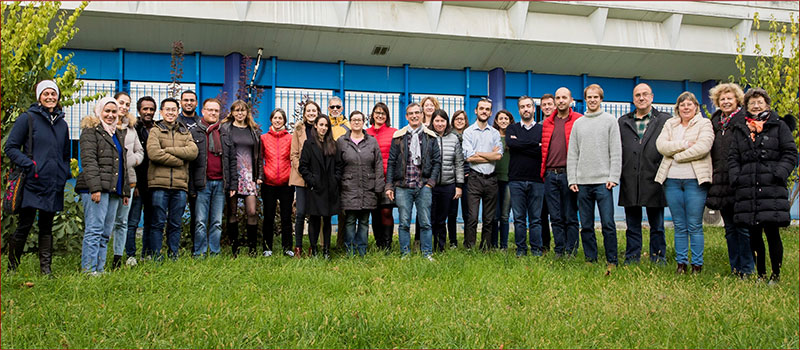Presentation
The activities of the MIEL team encompass electrochemistry and materials science, and mainly deal with electrochemical conversion and storage of energy of low (battery, PEMFC) and high (SOFC, SOEC) temperature devices. The cement of our activities and the use of electrochemical methodologies and common descriptors are focusing on the electrolyte, the electrodes and their interfaces.
A team strength is to combine the conception and manufacturing of the functional materials, their in-depth characterizations (physico-chemistry, electrochemistry), and their integration in electrochemical devices related to the targeted application.
The team activities are decomposed in 4 scientific axes that illustrate our expertise (synthesis, elaboration, characterization, electrochemistry) which are fed by numerous international and national collaborations. In addition, the experimental activities are exploiting a wide range of specific devises and different platforms such as the Battery, Raman, and M2E; all managed by the MIEL team for the LEPMI laboratory.
Membres de l'équipe

Scientifics axes
Inorganic- and organic-based electrolytes and electrodes for electrochemical generators
We design, synthesize, and elaborate dry and gelled polymer electrolyte, composite polymer electrolytes as well as polymer or redox molecules and electrodes. We are also looking at monomer or polymer synthesis of coordination complexes comprising transition metals (e.g. Cu, Fe, Ni). Electrodes are formulated via solvent cast or ultrasonic pulverization technique. The properties are assessed by ex situ electrochemical characterizations (transport, redox) and physico-chemical (structure, microstructure, thermodynamics…) as well as full cell such as fuel cell (PEMFC, SAFC), batteries (Li-polymer, Li-sulfur, Li-ion, Na-ion, divalent cation), photochemical cells, and redox flow batteries.
In situ & operando characterizations and technics
We develop electrochemical methodologies and experimental setups that permit, by the coupling electrochemical characterizations with advanced characterization technics sensitive to chemistry, structure, or microstructure, such as Raman spectroscopy, SAXS/SANS, X-ray or Neutron microtomography, etc., to study the behavior of materials and interfaces while the device is under operation. We are interested in dynamical evolutions, on both morphological and structural which can lead to a premature device ageing. We have access to lab-scale apparatus (in situ) and to large-scale facilities via proposals (operando, ESRF, ILL, SOLEIL, etc.).
Elaboration and characterizations of oxide and ceramic based materials
We design oxide, ceramic, and phosphate-based anions, multi-materials, and architecture materials via the use of innovative processing methods or sintering such as electrospray deposition (ESD), serigraphy, flash sintering. The charge transport properties within the materials and at the interfaces are at the heart of the studies as the targeted applications concern fuel cell and high temperature electrolyzers, solid-state batteries, and health applications.
Electrochemical devices, transport, and interfacial reactivities
We analyze by advanced electrochemical methodologies such as impedance spectroscopy the charge transport properties within materials (liquid, polymer, ceramic, composite, etc.) and the interfacial kinetic processes (gas electrodes (fuel cells, electrolyzers), oxygen semi-permeable membranes, intercalation (LCO, NMC, LMNO) and conversion (Sulfur) reactions, and metal-based electrodes (Li, Ca, Mg)).
Highlights
-
Solvent-Free Single-ion Conducting Polymer Electrolyte for Lithium-Metal Batteries Synthesized Via a Unique Donor-Acceptor Copolymerization.
Yunfan Shao, Fannie Alloin, Dominic Bresser, Cristina Iojoiu. J. Mater. Chem. A, 2024,12, 30032-30040. DOI : 10.1039/D4TA05055J -
Synthesis and Study of the Application of Iron, Nitrogen-Doped High-Surface-Area Carbon for Li–S Batteries.
Sajad Rahimi, Laureline Lecarme , Nathalie Job, Fannie Alloin. Applied Materials & Interfaces, 2025, 17 (26), pp.38031-38040. DOI : 10.1021/acsami.5c05993 -
Tuning ceramic surface to minimize the ionic resistance at the interface between PEO- and LATP-based ceramic electrolyte.
Léa Mangani, Didier Devaux, Anass Benayad , Christian Jordy, Renaud Bouchet. ACS Applied Materials & Interfaces, 2024, 16 (34), pp.45713-45723. -
Understanding Fast Charging Ability Limitation in Graphite Electrode for Li-Ion Batteries: Quasi-Thermodynamic Approach and Methodology.
Corentin Renais , Marta Mirolo , Maxime Servajon, Jakub Drnec, Fannie Alloin, Claire Villevieille. Chemistry of Materials, 2025, 37 (15), pp.5647-5657; DOI : 10.1021/acs.chemmater.5c00722



